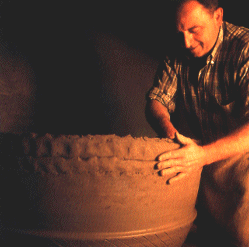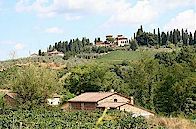Impruneta terracotta kilns
Mario Mariani
Via Capello 29
This small kiln is definitely worth a visit. You will often be able to see Mario Mariani making huge garden vases entirely by hand from the ground up. With luck, you might see him firing up his wood-burning kiln, identical to those used since at least Roman times. No thermometers. He assesses the heat by the colour of the white-hot pots. Mario used these traditional techniques to make the tiles used in the restoration of several famous Tuscan churches.
Via Capello 29
This small kiln is definitely worth a visit. You will often be able to see Mario Mariani making huge garden vases entirely by hand from the ground up. With luck, you might see him firing up his wood-burning kiln, identical to those used since at least Roman times. No thermometers. He assesses the heat by the colour of the white-hot pots. Mario used these traditional techniques to make the tiles used in the restoration of several famous Tuscan churches.

Click the smaller images for a larger picture
Impruneta Terracotta
The Middle Ages
The economic growth and the population increase of the 12 C and 13 C encouraged the development of what was to become the main manufacture in Impruneta. The population exploited local clay that was of a quality suitable for making all kinds of bricks and vessels. And so, already by the end of the 13 C, the production of terracotta was no longer a secondary activity. On March 23rd 1309, in fact, 23 local potters met to draw up the statute for this craft “mezzinariorum et urceorum plebatus Sancte Marie Impinete”. This document shows how local production consisted of jugs (“mezzine”) for transporting water and jars (“orci”) for storing liquids and grain. Although they are not mentioned in the statute, presumably all kinds of bricks and tiles were also fired in the same kilns.The current state of research does not allow us to follow local production through the 14 C, but land registers from the 15 C show how, in the centre of Impruneta alone, there were at least ten factories in continuous production. In addition, for that period, there is an increase in the documents related to the supplies from the owners of these local kilns to hospitals and convents in Florence. The development of earthenware in the late Middle Ages is also evidenced by the emigration of these craftsmen. Potters from Impruneta could be found in various Tuscan cities such as San Gimignano, Asciano and Anghiari and later in Rome.
The development of techniques for making jars
In the 16 C, the relationship between the Florentine market and the Impruneta kilns became even more important, and while the production of manufactured objects for household use (“mezzine” and basins) was cut down, the production of jars for the storage of olive oil increased. Garden terracotta objects, specially large plant pots were manufactured here too.The evolution of agriculture in Tuscany and in particular the increase in the cultivation of olive trees (due to the spread of sharecropping and the setting up of farms), resulted in the growing importance of olive oil jars, and also determined a progressive change in their shape. The need to store a larger quantity of oil meant an increase in the size of these jars, both in height and diameter.
Between the 16 C and the 17C, these “orci” acquired an increasingly impressive appearance which created no small difficulty in the manufacturing technique. The great skill that the kiln owners showed in transforming their products, together with the superior quality of the local clay, which made these jars more beautiful and long-lasting than those from other production centres, put the final seal on the success of Impruneta earthenware production.
The dynasties of kiln owners
Recent efforts to trace the family trees of these kiln owners shows the establishment of dynasties of potters who continued to join the Casini, Boncioli and Brandi families, and for whom we have documents from the 14 C and the 15 C.In many cases an expansion of different branches of the same family is recorded. In the 16 C the first of the famous surnames such as Cicali, Codacci and Falciani (altogether the most numerous) begin to appear, and also Vantini, while in the following century other names appear, including Lottini, Poggi, Scacciati, Soderi and Vanni. Finally, in the 18 C, we can follow the family history of the Agresti, Montauti-Danti and the Ricceri.
From the beginning of the Modern Era to our day
Between the 17 C and the 18 C, Impruneta kiln owners learnt how to vary their activity by adding a lead glaze which was very durable but did not lend itself easily to any kind of coating.The Grand Duke’s inquiry in 1768 indicated that between 1764 and 1768, they produced each year at least 736 oil jars, over 500 “plant and flower pots”, 700 basins and the same number of large plant pots, as well as about 120 bases for lemon trees, and at least 6 statues in terracotta.
The 19 C was a time of considerable growth for Impruneta terracotta, with new dynasties of kiln owners (Parenti, Manetti, Nistri, Malavolti and Bianchi) and with the beginning of mechanization which affected, above all, the manufacture of bricks and tiles. At the beginning of the “industrial takeoff” in Italy, in 1881, there were 22 terracotta factories in Impruneta and the most important was that of the Agresti family.






